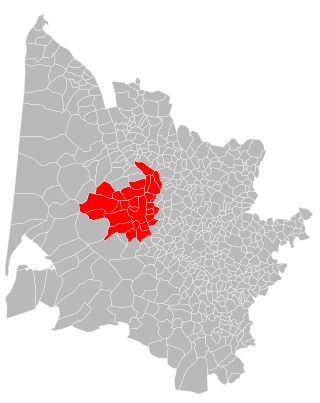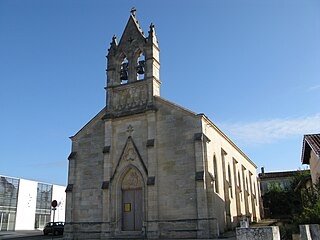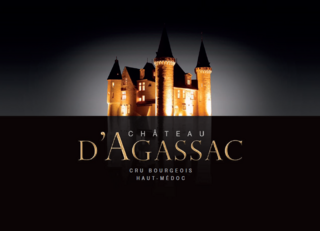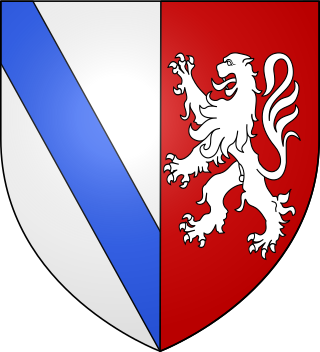
Gaillard IV de Durfort, Lord of Duras (died 1481), was a 15th-century Gascon noble of the Durfort family.

Gaillard IV de Durfort, Lord of Duras (died 1481), was a 15th-century Gascon noble of the Durfort family.
Durfort was the eldest son of Gaillard III de Durfort and his wife Judiote of La Lande. [1] A minor upon his father's death in 1444, he inherited the titles and possessions of his father. He obtained in 1446 a safeguard or conduct to go to England and to return to Aquitaine at his pleasure. [2]
Durfort was one of the main vassals of the Duchy of Gascony. On 12 June 1451, he signed as representative of the nobility of Bordeaux, the treaty of capitulation of the city before the French army led by Jean de Dunois, Count of Dunois. The French, anxious to conciliate the inhabitants of the region, offered them favourable conditions and they were permitted to maintain their existing titles and lands. The following year, he returned to the favour of the English, contributing to the return of Bordeaux to John Talbot, Earl of Shrewsbury. In 1453, after the French victory at the Battle of Castillon, the French routed the English forces from Gascony. The Count of Clermont invaded the Medoc and took Castelnau, while other French troops captured Cadillac. The castle of Blanquefort, held by Durfort, was the last to surrender.
After the capture of Bordeaux, King Charles VII of France issued directions that the leaders of the insurrection were to be saved, but to be exiled from France. Durfort went to England, and his property in France, the lands and castles of Blanquefort, Duras and Villandraut, with the barony of Duras, were confiscated and entrusted to vassals loyal to the crown.
He obtained from King Edward IV of England the office of governor of Calais, which he defended against French attacks. He was knighted as a member of the Order of the Garter, and remained faithful to Edward during the War of the Roses. In 1470, he was chamberlain to the Charles the Bold, Duke of Burgundy, whilst still retaining his functions at the English court. In 1473 Edward IV gave him the Lordship of Lesparre in the Medoc, a purely symbolic act and title since the English no longer had any control in Gascony. [3] In 1474 he was one of the negotiators of the Treaty of London (25 July 1474), a temporary alliance between the Duchy of Burgundy and the Kingdom of England. Durfort was sent in 1475 at the head of the English army to attempt to reclaim the Duchies of Brittany and Burgundy.The English troops landed at Calais in June 1475, but didn't advance and withdrew in September. [4]
King Louis XI of France recalled Durfort to France in June 1476 and returned his titles, lands and the castles of Blanquefort, Duras and Villandraut. As a result of Durfort's change of allegiance, he was expelled from the Order of the Garter. [5] Durfort was killed during a battle in Burgundy about 1481.
Durfort married Anne, daughter of William de la Pole, 1st Duke of Suffolk, and probably illegitimate. They had the following known children:
He also had an illegitimate son Bertrand.

Bordeaux Métropole is the métropole, an intercommunal structure, centred on the city of Bordeaux. It is located in the center of the Gironde department, in the Nouvelle-Aquitaine region, in South West France. It represents about half of the department's population. It was created in January 2015, replacing the previous Communauté urbaine de Bordeaux. It brings together 28 municipalities, and covers an area of 578.3 km2 (223.3 sq mi). Its population was 801,041 in 2018, of which 257,068 resided in Bordeaux proper.

The Durfort family is an old French noble family, distinguished in French and English history. It originated as feudal lords of Durfort, Tarn, a village of south-western France.
Château Lascombes is a winery in the Margaux appellation of the Bordeaux region of France. The wine produced here was classified as one of fifteen Seconds Crus in the original Bordeaux Wine Official Classification of 1855. In the 1950s, the estate was purchased by French wine writer Alexis Lichine who continued to own part of the estate till 1971 when Bass Charrington took over principal ownership. In 2001 it was purchased by Yves Vatelot and US-based Colony Capital, who in 2011 sold it to the French insurance group MACSF. In addition to its premier cuvee, a second wine is also produced, under the name Chevalier de Lascombes. Additional brands are Château Segonnes, Rosé de Lascombes, Vin Sec Chevalier de Lascombes and Gombaud.

Guy Aldonce de Durfort, 1st Duke of Lorges, Marshal of France, (1630–1702) fought in the Franco-Dutch War mostly on the Rhine under his uncle Marshal Turenne, but in 1673 he was seconded to the Siege of Maastricht. Back on the Rhine, he fought at Entzheim in 1674, at Turckheim in January 1675, and at Sasbach in July 1675, where Turenne fell. He distinguished himself at the retreat from Sasbach and the ensuing Battle of Altenheim.

Blanquefort is a commune in the Gironde department in Nouvelle-Aquitaine in southwestern France. Blanquefort is an outlying commune of the Bordeaux metropolitan area.

Château Cantemerle is a winery in the Haut-Médoc appellation of the Bordeaux wine region of France, in the commune of Macau. The wine produced here was the final estate to be classified as one of eighteen Cinquièmes Crus in the Bordeaux Wine Official Classification of 1855. Its absence from the classification map featured at the 1855 Exposition Universelle de Paris created some controversy, even though it has been listed on all maps published after 1855. Some sources will include an asterisk next to Château Cantemerle listing in reference to this controversy. The estate has a long history in the Haut-Médoc with records detailing its existence since at least the 12th century and wine production since at least the 14th century. In the 19th century, the estate was hard hit by the phylloxera epidemic as well as grapevine attacks of downy mildew, after which production dropped nearly 50%. Towards the end of the 20th century, the estate was sold to French insurance group Les Mutuelles d'Assurance du Bâtiment et des Travaux Public who have contributed significant investment in the estate's vineyards and winemaking facilities.

Colonel Louis de Duras, 2nd Earl of Feversham, KG was an English Army officer and peer. Born in the Kingdom of France, he was marquis de Blanquefort and sixth son of Guy Aldonce, Marquis of Duras and Count of Rozan, from the noble Durfort family. His mother was Elizabeth de la Tour d'Auvergne,the sister of Henri de La Tour d'Auvergne, Viscount of Turenne. His two brothers Jacques Henri and Guy Aldonce were both appointed as Marshal of France. He was a Huguenot.

Blessed Pey Berland was the Archbishop of Bordeaux from 1430 until his abdication, during a pivotal time in the history of the city and of Gascony. During his tenure, the city of Bordeaux remained staunchly faithful to the King of England in the last phase of the Hundred Years' War, but the French took the city in 1451.

Rodrigo de Villandrando was a Spanish routier from Castile and mercenary military leader in Gascony during the final phase of the Hundred Years' War. He was famous for his pillaging and was consequently known as the Emperor of Pillagers or L'Écorcheur.
The treaty of Bruges of 1375 was a truce between the Kingdoms of England and France during the Hundred Years' War. It was signed on 27 June 1375 for one year, then extended on 12 March 1376 to 24 June 1377. King Charles V of France retained the territories conquered during his previous military operations. The Duchy of Brittany is returned to France, with the exception of Brest, Auray and Berval which remain the possessions of John IV of Brittany.

The de Roquefeuil-Blanquefort family previously named de Blanquefort is a French noble family from Aquitaine and Rouergue whose proven filiation began in 1393 when Jean of Blanquefort married Catherine de Roquefeuil-Anduze. Their son Antoine took his mother's name. The Roquefeuil-Blanquefort family gave several branches. The remaining two branches are Roquefeuil Monpeyroux and Roquefeuil Cahuzac. The Roquefeuil-Blanquefort family is a member of the Society of the Cincinnati.

Château de Gageac is an ancient monument from the 12th/14th/18th centuries. It is a château located near Gageac-et-Rouillac in the Dordogne department in south-west France. Constructed as a fortress in the 12th century, it was besieged in 1377 during the Hundred Years' War by troops loyal to Charles V of France. Later it was converted to a residence, and it has been in the ownership of the de Vivans family for six generations. A large dovecote facing the castle is a notable feature.

Château D'Agassac is a Haut-Médoc wine estate located in the village of Ludon-Médoc in the Médoc, 15 minutes away from the city of Bordeaux in France. Its red wine is a Cru Bourgeois ranked "Cru Bourgeois Exceptionnel" in the historic Bordeaux Wine Official Classification of 1932. The property is also a leader in enotourism.

Gaillard II de Durfort, Lord of Duras, Blanquefort, and Villandraut, and Seneschal of Gascony, was a 13th-14th century Gascon nobleman of the Durfort family.

Gaillard I de Durfort, known as the Archdeacon (l'Archidiacre), was a French priest and nobleman of the Durfort family. He inherited the Lacour–Durfort lands in 1345 and abandoned his clerical career to marry Marguerite de Caumont.
Alixandre de Caumont, also known as Anissant III de Caumont, Lord of Sainte Bazeille was a 14th century French noble.

Gaillard III de Durfort was a Gascon nobleman of the Durfort family. He inherited the lordship of Duras and Blanquefort from his father, Gaillard II, in 1422. In the Hundred Years' War between England and France, Gaillard took the side of the English king, who was the feudal suzerain of Gascony.
The Gascon campaign of 1450-1453 took place during the Hundred Years War when the kingdom of France undertook a military campaign to invade and cede the Duchy of Gascony from the English. Following the decisive victory of the French at the battle of Castillion and after the fall of Bordeaux, the last English stronghold in Gascony, English control of Gascony was removed.

The Battle of Blanquefort took place on 1 November 1450 during the Hundred Years War when a French army drew out Anglo-Gascon forces from Bordeaux in the English-controlled Duchy of Gascony. The Anglo-Gascon infantry suffered heavy losses, and the battle resulted in a French decisive victory. The battle was known locally as La Male Journade or in French Mauvaise Journée and marked the beginning of a campaign to drive the English from Gascony.
Jean Baptiste de Durfort, 3rd Duke of Duras was a French nobleman as the 3rd Duke of Duras and was created a Marshal of France while also having the additional rank of a Peer of France.